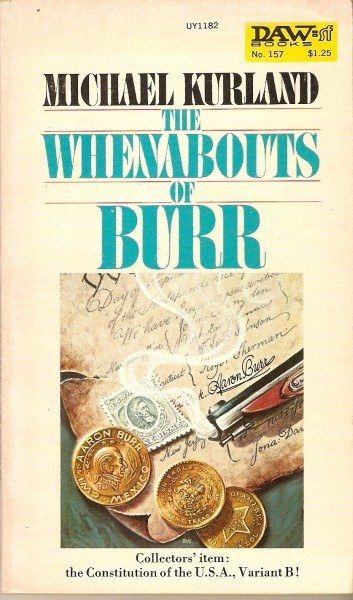Rose with the Sun
The Whenabouts of Burr
By Michael Kurland

14 Jun, 2020
Because My Tears Are Delicious To You
0 comments
Michael Kurland’s 1975 The Whenabouts of Burr is a standalone science fiction mystery novel.
Constitutional scholar Professor William Kranzler makes a momentous discovery. Someone has stolen the original American Constitution, replacing it with a very nearly identical copy. The copy has one flaw: where Alexander Hamilton’s signature should be, Aaron Burr’s signature appears.
President Gosport is determined to recover the document before his Republican foes (or worse, Democratic supposed allies) discover the theft. He can’t call on the FBI, because Gosport is utterly convinced that the FBI is out to get him. He also rules out every conventional law enforcement or intelligence group, believing there is no way to use them in this matter that would not end with a leak.
The President has an ace in the hole: he has quietly transformed the Bureau of Weights and Measures into his own private investigation agency. Thus, innocuously titled Field Observer Nathan Hale (Nate) Swift is handed the task of recovering the Constitution.
Assisted by retired detective Amerigo Vespucci “Ves” Romero, Nate sets out to solve the mystery. There are few clues, except that whoever stole the Constitution had exceptional resources. They managed to retrieve the document from a sealed helium-filled case without leaving any sign of break-in. Their fake seems utterly authentic, from the signatures to the age of the document itself. The only detail that’s off is the one that sent poor Kranzler swooning: Aaron Burr’s signature.
Burr is the oddity, therefore the pair go looking for other Burr-related anomalies. This produces inexplicable gold coins proclaiming Burr Emperor of Mexico. A newspaper ad that invites a deluge of crankery is for the most part unproductive, but also turns up a genuine curiosity: official USPS stamps with Burr’s face, when no such stamps have ever been issued.
Most curiously of all, one Alexander Hamilton appears in their office, with an interest in hiring the pair. Conflict of interest prevents Nick and Ves from cooperating overmuch. Instead, they follow their visitor. Their pursuit hits a brick wall when Hamilton visits a steam bath and while alone in a room with but one exit, vanishes.
Ves is a rational man. If Hamilton entered the room, did not use the door, but is no longer in the room, there must be a second exit. If it is not obvious then it must be concealed. A bit of methodical searching turns up a control panel of unfamiliar design. Alas, fiddling with it appears to produce no tangible results.
Until Ves and Nate open the door of the steam bath to find an entirely unfamiliar version of America outside. A version of America that is suspicious of unconventional people. A version of America whose secret police are quite good at detecting and detaining unconventional people …
~oOo~
Just to clarify: the item that was stolen was the physical artifact the American Constitution, which has tremendous historical and symbolic significance, and not the legal and political framework also known as the American Constitution, which is a quaint relic of no relevance to the modern world.
This is a very 1970s SF novel. The idea that an American President could be so consumed with paranoia as to see enemies in America’s law enforcement organizations simply reflects the fact that Richard M. Nixon’s behavior had an effect not just on the trivial world of American politics, but in the important world of science fiction as well1.
As you may have guessed, the novel takes a detour into alternate universes, with the unusual twist that Kurland’s various parallel universes advance through time at slightly different rates, so while the universe in which Ves and Nate start out in is in the far off futuristic year of 1996, the first world they visit is still in 1897. Other characters come from worlds even farther back in time, which permits Kurland to have both Alexander Hamilton and Aaron Burr as characters.
Of the two, Burr comes off as more charming, not least because he has not used his access to alternate universes to set up a pocket kingdom with Alexander Hamilton at the top and hornswoggled Native Americans at the bottom, whereas Alexander Hamilton has.
Whenabouts may be a somewhat jaundiced look at H. Beam Piper’s Paratime series2. The Primes, whose technology facilitates cross-time travel, have stagnated ever since they invented it. Satisfied to settle for filching from other cultures, they produce nothing of interest themselves.
Whenabouts is slight, perhaps because the comic novel is also very short. For fourteen-year-old me, it was my introduction to those colourful Americans, Alexander Hamilton and Aaron Burr. Neither Burr nor Hamilton figured prominently in Ontario history classes3. They seem like interesting characters. Somebody might produce a musical about one or the other of them.
The Whenabouts of Burr is available here (Amazon US), here (Amazon Canada), here (Amazon UK), here (Barnes & Noble), here (Book Depository) and here (Chapters-Indigo).
1: Kurland would later go on to author (with S. W. Barton) The Last President, which is an unsympathetic look at what might have followed had the Watergate burglars not been caught.
2: Kurland would later collaborate with the late H. Beam Piper on The First Cycle, a tale of first contact that does not go entirely well.
3: Ontario history courses could be very inclusive in their exclusion. They tended to be very British-focused, with regions farther abroad than France acknowledged only in passing. If at all.
